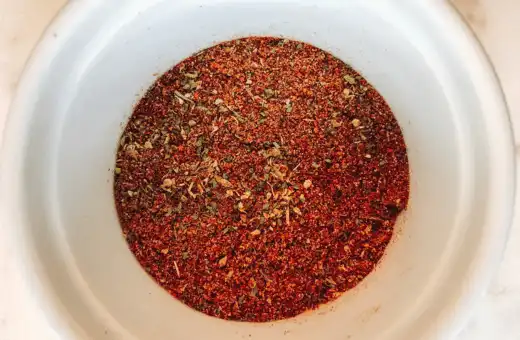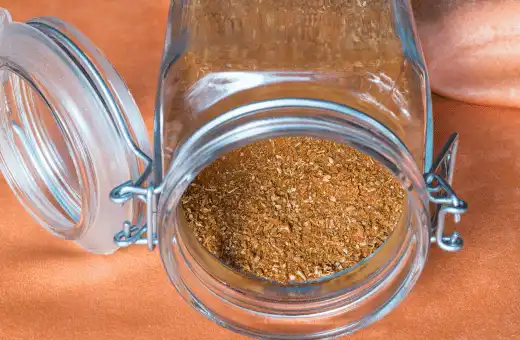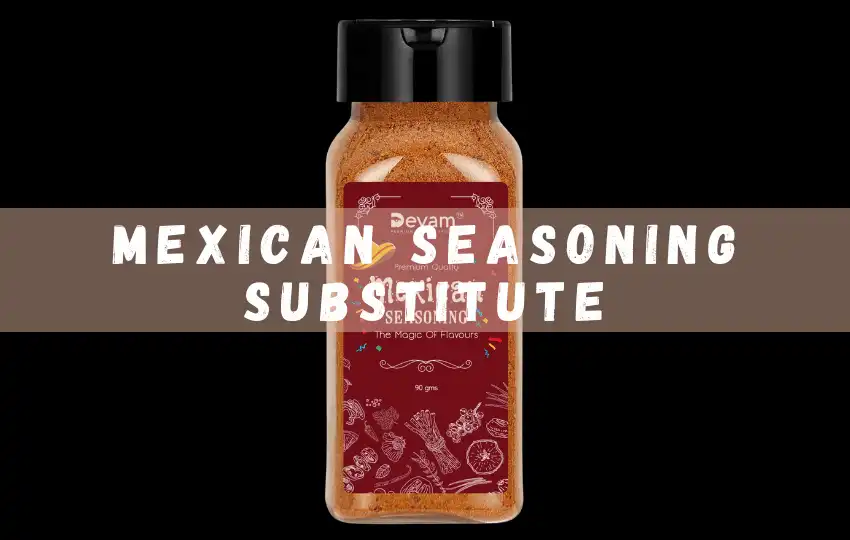Mexican seasoning is an essential ingredient in many delicious and authentic Mexican dishes. It adds a unique flavor profile to recipes, including a spicy kick, smoky taste, and notes of herbs and spices.
But what happens when you run out of Mexican seasoning or you can’t find it at your local grocery store?
Thankfully, there are several easy-to-find and equally delicious Mexican seasoning substitutes that you can use.
In this blog post, I’ll share with you the 8 best Mexican seasoning substitutes, their ratios, and how to use them in your cooking.
Whether you’re a seasoned home cook or just starting, this guide will help you take your Mexican-inspired dishes to the next level.
In short, " What can I use instead of Mexican seasoning?" Chili Powder and Paprika, Taco Seasoning, Adobo Seasoning, Fajita Seasoning, Sazon seasoning, Goya Sazon substitute, Chipotle Powder, Cumin and Coriander, Homemade Mexican Seasoning.
What is Mexican seasoning, and what does Mexican seasoning taste like?
Mexican seasoning is a blend of spices made from garlic, onion, cumin, chili pepper flakes and other herbs and spices.
It has an earthy flavor with spicy undertones that can be used to season tacos, enchiladas, quesadillas or any Latin-style dish.
The spice blend typically has a mild to medium heat level that adds depth and complexity without overwhelming the flavors of the food itself.
What is Mexican seasoning made of?
Mexican seasoning, also known as Mexican spice blend or Mexican spice mix, can vary depending on the recipe or personal preference.
However, here is a general list of common spices and herbs that are often included in Mexican seasoning:
1. Chili Powder: Typically made from ground dried chili peppers, it adds heat and a rich, smoky flavor to the seasoning.
2. Cumin: This spice is widely utilized in Mexican cuisine and adds a warm, earthy, and slightly nutty flavor.
3. Paprika: Adds a mild, sweet, and slightly smoky flavor to the seasoning blend.
4. Garlic Powder: Provides a savory and aromatic element to the mix.
5. Onion Powder: Adds a sweet and savory flavor reminiscent of onions.
6. Oregano: Mexican oregano is commonly used in Mexican seasoning. It has a robust flavor and adds a slightly citrusy and peppery note.
7. Coriander: Ground coriander seeds are used to add a fresh, citrusy flavor to the blend.
8. Salt and Pepper: These common seasonings help enhance the overall flavor of the blend.
Optional ingredients that may be included in some Mexican seasoning blends
1. Smoked Paprika: If a smoky flavor is desired, smoked paprika can be used in addition to or instead of regular paprika.
2. Cayenne Pepper: For extra heat, cayenne pepper can be added to the mix.
3. Cinnamon or Allspice: In certain Mexican recipes, a hint of cinnamon or allspice may be used to add warmth and complexity to the flavor.
Uses of Mexican seasoning
Mexican seasoning is a versatile ingredient that can use to add flavor to a variety of dishes.
Mexican seasoning can be used as an all-purpose seasoning for tacos, enchiladas, burritos, fajitas, soups and stews. It is also an excellent way to give some extra flavor to grilled meats like chicken or beef.
When using Mexican seasoning in recipes that call for it specifically, the measurements are usually given by weight or volume – typically one teaspoon per serving.
However, because Mexican seasoning blends are so flavorful and intense, it is important not to overuse them; adding too much can overpower the other ingredients in the dish.
In addition to its use as a flavoring agent in recipes and dishes such as those mentioned above, Mexican seasoning can also be added to marinades for meats before they are cooked in order to enhance their flavor.
Additionally, it can be sprinkled on vegetables before roasting or grilling them for extra flavor. Finally, Mexican seasoning is great for making homemade salsas.
Where to buy Mexican seasoning?
If you are looking for where to buy Mexican seasoning, there are a few different places you can go. Many specialty food stores carry it, as do some international grocery stores.
You can also order online from many retailers that provide a variety of diverse flavors and types of Mexican seasoning.
Best Mexican seasoning substitutes
1. Chili Powder and Paprika – a good Mexican seasoning substitute
Chili powder is a staple element in most Mexican dishes, but if you don’t have it on hand, you can use a combination of cumin and paprika instead.
Ratio or measurement: For every teaspoon of chili powder, use ½ teaspoon of cumin and ½ teaspoon of paprika.
2. Taco Seasoning

If you’re making tacos or other Mexican dishes that require taco seasoning, you can make your own blend by combining cumin, chili powder, garlic powder, onion powder, dried oregano, and salt.
Ratio or measurement: Use 2 teaspoons of each spice and 1 teaspoon of salt for every ¼ cup of taco seasoning called for in the recipe.
3. Try Adobo Seasoning in place of Mexican seasoning
Adobo seasoning is a blend of oregano, garlic, cumin, and chili powder, among other spices. To make your own adobo seasoning, use equal parts oregano, garlic powder, and cumin, and add a pinch of chili powder.
Ratio or measurement: Use 1 tablespoon of this blend for every 2 tablespoons of adobo seasoning called for in the recipe.
Learn more: Best Adobo sauce substitutes
4. Fajita Seasoning

Fajita seasoning typically consists of chili powder, cumin, paprika, garlic powder, and onion powder.
Ratio or measurement: To make your own blend, use 1 tablespoon of chili powder, 1 tablespoon of cumin, paprika, garlic powder, and 1 teaspoon of onion powder for every ¼ cup of fajita seasoning called for in the recipe.
5. Sazon seasoning – a tasty Mexican seasoning alternative
Sazon seasoning is a popular seasoning blend used in Latin American and Caribbean cuisine.
To make your own, mix together ground coriander, cumin, garlic powder, onion powder, paprika, and annatto powder (for the signature orange color).
Ratio or measurement: Use 1 tablespoon of this blend for every packet of seasoning called for in the recipe.
6. Goya Sazon substitute

Goya Sazon is a widely used spice blend in Mexican and Latin American cooking.
To make your own substitute, mix together onion powder, garlic powder, ground cumin, ground coriander, dried oregano, and salt.
Ratio or measurement: Use 1 tablespoon of this blend for every packet of Goya Sazon called for in the recipe.
7. Chipotle Powder – a decent Mexican seasoning replacement
Chipotle powder adds smoky and spicy notes to Mexican dishes. If you don’t have it, you can make your own by grinding up dried chipotle peppers or using smoked paprika.
Ratio or measurement: For every teaspoon of chipotle powder, use ¼ teaspoon of smoked paprika or 2 dried chipotle peppers.
8. Cumin and Coriander

Cumin and coriander are two essential spices in many Mexican dishes. They provide a warm, earthy, and slightly spicy flavor. For every teaspoon of Mexican seasoning,
Ratio or measurement: use 1/2 teaspoon of cumin and 1/2 teaspoon of coriander. Together they create a perfect Mexican seasoning substitute that can be used in guacamole, chili, and stews.
Tips on How to Choose the Most Suitable Substitution Option for Mexican Seasoning
When choosing a substitution option for Mexican seasoning, consider the following tips:
1. Flavor profile: Mexican seasoning typically includes a combination of spices like chili powder, cumin, paprika, garlic powder, onion powder, oregano, and sometimes cayenne pepper.
Look for spice blends or individual spices that can replicate the smoky, earthy, and slightly spicy flavors of Mexican cuisine.
2. Heat level: Consider the desired level of spiciness in your Mexican seasoning. You can reduce or omit ingredients like cayenne pepper or granulated red pepper flakes if you prefer a milder flavor.
On the other hand, if you prefer a spicier seasoning, you can add additional heat-inducing spices.
3. Regional variations: Mexican cuisine varies across different regions, and each may have its unique spice blend.
Consider the specific Mexican dish you’re preparing and its regional influences. Research traditional spice combinations used in that particular region to ensure an authentic flavor.
4. Fresh ingredients: Using fresh herbs and spices can enhance the flavor of your Mexican seasoning. Consider using fresh cilantro, oregano leaves, or garlic instead of their dried counterparts for a more vibrant taste.
5. Sodium content: Some store-bought Mexican seasoning blends may contain added salt. If you’re watching your sodium intake, opt for low-sodium options or make your own blend using individual spices to control the salt content.
6. Allergies and dietary restrictions: Take into account any allergies or dietary limitations you or your guests may have. Ensure that the substitute spices or blends you choose are suitable for everyone.
7. Experiment with ratios: Mexican seasoning blends can vary in the ratios of spices used. Start with a basic combination of spices and modify the amounts based on your taste preferences.
Taste and adjust as needed until you achieve the desired flavor profile.
8. Store-bought alternatives: If you prefer convenience, there are various store-bought Mexican seasoning blends available.
Read the labels and ingredient lists to find one that closely matches the flavor profile you’re looking for.
Consider checking reviews to ensure the quality and authenticity of the blend.
Homemade Mexican Seasoning
Certainly! Here’s a basic recipe for homemade Mexican seasoning that you can alter to fit your taste preferences.
Feel free to adjust the quantities or add additional spices to create your desired flavor profile:
Ingredients:
– 2 tablespoons chili powder
– 1 tablespoon ground cumin
– 1 tablespoon paprika
– 1 tablespoon garlic powder
– 1 tablespoon onion powder
– 1 teaspoon dried oregano
– 1 teaspoon salt
– 1/2 teaspoon black pepper
– Optional: 1/2 teaspoon cayenne pepper (for extra heat)
Instructions:
1. In a small bowl, blend all the spices: chili powder, cumin, paprika, onion powder, dried oregano, salt, black pepper, garlic powder, and cayenne pepper (if using).
2. Mix well to ensure that all the spices are evenly combined.
3. Taste the seasoning and adjust the quantities according to your preference. You can add more or less of any spice to customize the flavor to your liking.
4. Transfer the homemade Mexican seasoning to an airtight container or spice jar.
5. Store in a cool, dry area away from direct sunlight. It should remain fresh for several months.
To use homemade Mexican seasoning
– Sprinkle it on ground beef, chicken, or other meats when making tacos, fajitas, or enchiladas.
– Utilize it as a rub for grilled or roasted meats.
– Add it to soups, stews, or chili to enhance the Mexican flavors.
– Incorporate it with olive oil or lime juice to make a marinade for meats or vegetables.
Conclusion on Mexican seasoning substitute
In conclusion, Mexican seasoning is an essential ingredient in many Mexican-inspired dishes, but there are several easy-to-find and equally delicious substitutes that you can use.
Whether you’re out of Mexican seasoning or just want to try something different, these substitutes are sure to take your dishes to the next level.
Remember to adjust the ratios to your taste preference and experiment with different spice blends. Happy cooking!
FAQs on Mexican seasoning substitute
Q1. What is similar to Mexican seasoning?
Similar seasonings to Mexican seasoning include Southwestern, Tex-Mex, chili, and Cajun seasonings.
Each of these blends has a unique flavor profile that includes a combination of herbs and spices like chili powder, cumin, garlic powder, oregano, paprika and more.
They can be used to make flavorful dishes such as tacos, burritos or fajitas. Additionally, they can be counted as soups or stews for an extra kick of flavor.
Q2. What can I use if I don’t have Mexican seasoning?
If you don’t have Mexican seasoning, you can make your own blend of spices to create similar flavors.
Utilize a combination of cumin, chili powder, garlic powder, oregano, onion powder, and smoked paprika to get the smoky heat associated with classic Mexican dishes. You can also add a pinch of ground coriander for added complexity and depth of flavor.
For some sweetness, use ancho chili powder or chipotle pepper powder. If you want more spice, add crushed red pepper flakes or cayenne pepper. Lastly, feel free to adjust the ratios to suit your taste!
Q3. Is Mexican seasoning the same as taco seasoning?
Mexican seasoning and taco seasoning are similar in some ways but not exactly the same.
Mexican seasoning refers to a blend of spices commonly used in Mexican cuisine, while taco seasoning specifically refers to a blend of spices used to season ground beef or other meats for making tacos.
Taco seasoning typically includes a combination of spices such as chili powder, cumin, paprika, garlic powder, onion powder, and sometimes oregano, salt, and pepper.
These spices are mixed together to create a flavor profile that is often associated with tacos.
On the other hand, Mexican seasoning is a more general term encompassing a wide range of spice blends used in Mexican cooking.
The specific spices and ratios used in Mexican seasoning can vary depending on the recipe or region, but common ingredients may include chili powder, cumin, coriander, oregano, paprika, garlic powder, onion powder, and sometimes cinnamon or cloves.
Mexican seasoning can be used to flavor a variety of dishes beyond just tacos, such as enchiladas, fajitas, or Mexican rice.
While there may be some overlap in the spices used, taco seasoning is more specialized for seasoning ground meat for tacos specifically, whereas Mexican seasoning can be a more versatile blend used in various Mexican dishes.
Q4. What is the famous Mexican seasoning?
One of the most famous and widely recognized Mexican seasonings is called “Taco Seasoning.”
Taco seasoning is a famous spice blend used to season ground beef or other meats for making tacos. It is widely available in stores and often used in Mexican-inspired dishes around the world.
The exact ingredients in taco seasoning can vary between brands and recipes, but it typically includes a mixture of spices such as chili powder, cumin, paprika, garlic powder, onion powder, and sometimes oregano, salt, and pepper.
These spices work together to construct a flavorful and aromatic seasoning that is associated with the taste of tacos.
Taco seasoning is convenient to use as it combines various spices into one blend, making it easy to season meat quickly and achieve a desired Mexican-inspired flavor profile.
Q5. What can I use instead of chili powder for Mexican style?
Instead of chili powder, you can use a combination of other Mexican spices for a similar flavor.
This can include a mix of cumin, oregano, garlic powder, paprika, and optionally cayenne pepper. The proportions used depend on how spicy or mild you want your dish to be.
Cumin is often the most prominent spice in this blend as it provides the signature smoky flavor associated with Mexican cuisine. Oregano adds an herbal note, and garlic powder brings out the savory.
notes in dishes. Paprika adds a subtle sweetness and can be mild or hot, depending on the variety used. To give your dish some extra heat, add some cayenne pepper into the mix as well.
Q6. How do you season without seasoning?
You can season without seasoning by using other natural ingredients to add flavor to your food.
Some examples include adding fresh herbs and spices, such as garlic and onion powder, dried thyme, oregano, parsley, cilantro or basil.
Using the zest of citrus fruits like lemons or limes for a flavorful twist; incorporating natural sweeteners like honey or maple syrup; adding nuts and seeds to dishes for crunch and extra protein; utilizing vinegar such as balsamic vinegar or rice vinegar for acidity.
Experiment with different fats like olive oil or avocado oil for richness. These ingredients can help make any dish taste delicious without relying on processed seasoning mixes.


